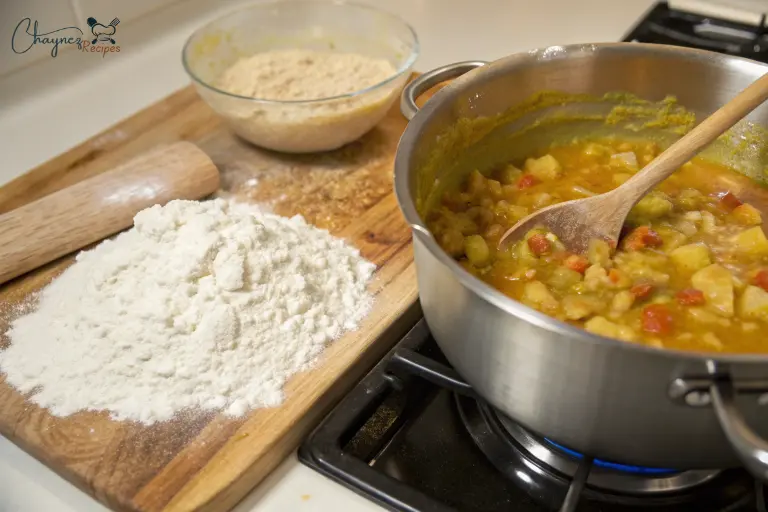When it comes to making a pot pie, one of the most critical components of the recipe is the filling. It should be rich, creamy, and thick enough to stay inside the crust without leaking out. However, many home cooks face the challenge of achieving just the right consistency. So, how do you thicken a pot pie filling to get that perfect balance between a hearty texture and a smooth, satisfying mouthfeel?
In this article, we’ll dive into various methods that can help you answer the question, How do you thicken a pot pie filling? Whether you’re working with chicken, beef, or vegetables, we’ll cover a range of techniques and ingredients from traditional flour-based thickeners to creative, natural options that will help you achieve the perfect pot pie every time.
Understanding how to thicken the filling is crucial not only for texture but also for flavor. A filling that’s too runny can result in a soggy crust, while one that’s too thick can feel dry or overly heavy. In this guide, we’ll walk you through everything you need to know about thickening a pot pie filling, so you can enjoy a comforting, delicious dish with the ideal consistency.
Why Is Pot Pie Filling Important?
Before answering the question, How do you thicken a pot pie filling?, let’s take a moment to understand why the filling is so important. Pot pie filling serves as the heart of the dish. It should be rich, creamy, and flavorful, while maintaining a thick consistency that holds together when cut.
A filling that is too runny will seep out of the crust, leaving you with a soggy and unappetizing dish. On the other hand, if the filling is too thick, it can result in a dry and overly dense pot pie. Therefore, getting the right texture is crucial to making a pot pie that both looks and tastes great.
Common Ingredients for Pot Pie Filling
Before we dive into thickening methods, let’s review the typical ingredients used in pot pie fillings. These ingredients usually include:
- Protein: Chicken, turkey, beef, lamb, or vegetables.
- Vegetables: Carrots, peas, potatoes, celery, onions.
- Broth or Stock: Chicken broth, beef broth, or vegetable stock.
- Creamy elements: Heavy cream, milk, butter, or a combination.
- Seasonings: Salt, pepper, thyme, rosemary, garlic, etc.
The consistency of the filling largely depends on how these ingredients are combined and cooked together.
How Do You Thicken a Pot Pie Filling? Key Methods
Now that we’ve established the importance of the filling, let’s focus on the main question: How do you thicken a pot pie filling? There are several effective methods you can use, depending on the ingredients available and the desired outcome.
1. Use Flour or Cornstarch Slurry
One of the most common ways to thicken a pot pie filling is by creating a flour or cornstarch slurry. This method is straightforward and doesn’t require special ingredients. Both flour and cornstarch are excellent thickening agents, but they behave slightly differently.
- Flour: Mix equal parts flour and cold water to create a paste. Gradually add this paste to the simmering filling while stirring. Flour will create a thicker, creamier texture.
- Cornstarch: Mix one tablespoon of cornstarch with two tablespoons of cold water. Add this mixture to the hot filling and stir until it thickens. Cornstarch tends to thicken quickly and produces a clearer, more translucent filling.
Pro Tip: Always add the slurry slowly and stir continuously to avoid lumps in your filling.
2. Use a Roux (Butter and Flour)
A roux is a classic technique for thickening sauces and fillings. It involves cooking equal parts flour and fat (usually butter) together to form a paste, which can then be incorporated into the pot pie filling.
Here’s how to make a roux:
- In a saucepan, melt butter over medium heat.
- Slowly whisk in an equal amount of flour to form a paste.
- Continue to cook and stir the mixture for 2-3 minutes to remove the raw flour taste.
- Gradually add the roux to your pot pie filling, stirring continuously until it thickens.
A roux provides a rich, smooth texture to the filling and is especially useful for a creamy pot pie.
3. Add Heavy Cream or Milk
In some cases, a creamy filling may need additional thickness. Adding heavy cream or milk can help thicken the mixture while also enhancing its richness. If the filling is too thin but you want to avoid an overly heavy texture, add a small amount of cream or whole milk. Be sure to stir constantly to incorporate it into the filling.
Tip: Heavy cream works best for a velvety, smooth consistency, while milk will provide a lighter texture.
4. Mashed Potatoes or Potato Flakes
If you’re looking for a natural thickener that also adds heartiness to your pot pie, consider using mashed potatoes or instant potato flakes. These ingredients are particularly useful in vegetable pot pies.
- Mashed potatoes: Adding a few spoonfuls of mashed potatoes can thicken the filling and give it a creamy texture. The potatoes will also add bulk, making the filling more substantial.
- Potato flakes: If you’re in a rush or prefer not to cook additional ingredients, instant potato flakes can be added directly to the filling. Just be cautious, as they can thicken quickly.
5. Reduce the Filling by Simmering
Another simple method to thicken your pot pie filling is to allow it to reduce. After all your ingredients are combined, simmer the filling uncovered over medium heat for 10-15 minutes. This will allow excess liquid to evaporate, resulting in a thicker, more concentrated filling.
Be sure to stir occasionally to prevent the filling from sticking to the bottom of the pan. While this method requires patience, it is one of the easiest ways to achieve a thickened filling without adding extra ingredients.
6. Arrowroot Powder as a Thickener
Arrowroot powder is a gluten-free alternative to cornstarch and flour. It works similarly by creating a slurry when mixed with cold water. Add the slurry to your filling and stir until thickened. Arrowroot provides a glossy, smooth texture, making it an ideal choice for a pot pie filling with a clear, shiny appearance.
7. Use a Beurre Manié
A beurre manié (pronounced bur ma-nay) is another French technique for thickening sauces and fillings. This method involves combining equal parts softened butter and flour into a paste. Unlike a roux, a beurre manié is added directly to the pot pie filling without cooking beforehand. It thickens the mixture almost instantly.
To make beurre manié:
- Mix equal parts softened butter and flour to form a paste.
- Whisk the paste directly into the simmering pot pie filling.
- Stir constantly until the desired thickness is achieved.
This method creates a smooth and rich texture, making it perfect for a classic pot pie.

How to Avoid Common Thickening Mistakes
Thickening a pot pie filling seems simple, but there are several common mistakes that can throw off your dish. Understanding these pitfalls will help you achieve the ideal consistency and avoid the frustration of a runny or overly thick filling. Let’s take a closer look at the most frequent errors and how you can avoid them, so you can confidently answer the question: How do you thicken a pot pie filling?
1. Over-Thickening the Filling
One of the most common mistakes when thickening a pot pie filling is going too far with the thickening agent. It’s easy to get carried away, especially when you’re trying to achieve the perfect consistency. However, over-thickening can make your filling clumpy, dry, or too dense.
Solution:
To prevent this, always add your thickening agent gradually. Start with a small amount, stir it in well, and then check the consistency. You can always add more if needed, but you can’t fix an overly thickened filling. Keep in mind that the filling will continue to thicken slightly as it cools, so stop when it’s slightly thinner than you want it to be.
2. Not Stirring Enough
When adding a thickening agent, whether it’s a flour slurry, cornstarch, or a roux, it’s essential to stir constantly. Failure to do so can lead to clumps forming, ruining the smooth texture of your filling.
Solution:
Stir the filling continuously while adding your thickener. If you’re using flour or cornstarch, create a slurry by mixing it with cold liquid before incorporating it into the hot filling. This method helps to avoid lumps and ensures a smooth, evenly thickened filling. Additionally, ensure that you cook the filling long enough after adding the thickener to allow it to fully incorporate and thicken.
3. Adding Thickener to Hot Liquid Without Proper Mixing
Another mistake is adding a thickening agent directly to hot liquid without first mixing it with cold water or broth. If you don’t properly dilute the thickening agent, it can cause clumping and uneven thickening.
Solution:
Always mix the thickening agent with a small amount of cold liquid before adding it to the hot filling. This “slurry” process prevents lumps and allows for a smooth and controlled thickening process. For flour, a paste works well, while cornstarch should be mixed with cold water or broth. Only then should you slowly pour it into the hot mixture, stirring constantly.
4. Not Allowing the Filling to Simmer Long Enough
Sometimes, home cooks may think the filling is thickened enough after adding their thickening agent, but in reality, it needs more time to properly incorporate. Not letting the filling simmer long enough after thickening can result in an undercooked and runny filling.
Solution:
After adding your thickening agent, allow the filling to simmer gently for 5-10 minutes. This allows the starches to fully activate and thicken the liquid. It also ensures that any raw flour taste is cooked off. If your filling hasn’t thickened as expected, let it simmer a little longer before deciding to add more thickener.
5. Using the Wrong Thickening Agent
Each thickening agent behaves differently. Flour creates a creamy, slightly opaque filling, while cornstarch gives a clearer, more translucent result. Using the wrong thickener can lead to undesirable textures or flavors in your pot pie filling.
Solution:
Choose your thickening agent based on the desired result. If you want a rich, creamy texture, a roux (flour and butter) or a flour slurry is a great option. For a clear, glossy filling (especially if using a protein-heavy filling like chicken), cornstarch or arrowroot powder works better. Experiment with different agents based on the filling type and texture you prefer.
6. Ignoring the Role of Fat in Thickening
Fat plays a crucial role in the thickening process, especially when using methods like roux or beurre manié. Skipping or using too little fat can result in a thin, greasy filling instead of a smooth and velvety one.
Solution:
When making a roux or beurre manié, ensure you use the right ratio of fat to flour. Generally, equal parts butter and flour are recommended. The fat helps create a silky texture that binds the ingredients together. If you’re using other methods, consider incorporating a bit of butter or cream to improve the filling’s richness and prevent it from becoming too dry or chalky.
7. Not Adjusting the Consistency After Baking
After you’ve prepared your pot pie filling and placed it in the oven, the filling can sometimes thicken further as it bakes and cools. If you didn’t add enough liquid to your filling before baking, it might become too thick or even dry out in the oven.
Solution:
Before baking, ensure that your filling has the right consistency. It should be thick enough to stay inside the crust, but still loose enough that it doesn’t dry out during baking. If your filling is too thick, consider adding more liquid (such as broth or cream) before placing the pie in the oven.
8. Not Considering the Effects of Different Fillers
Certain ingredients, such as potatoes or vegetables, naturally absorb liquid during cooking, which can alter the filling’s consistency. If you add too many starchy vegetables like potatoes, they may soak up the broth and cause your filling to thicken more than you want.
Solution:
When using starchy vegetables or potatoes in your filling, be mindful of how much liquid you add. You may need to adjust the amount of broth or stock in the recipe to account for the moisture absorbed by the vegetables. Alternatively, consider mashing some of the potatoes or vegetables to release their starch and help thicken the filling naturally.
Final Thoughts on Avoiding Common Thickening Mistakes
Achieving the perfect pot pie filling requires attention to detail and patience. By avoiding these common thickening mistakes, you’ll be able to create a filling that’s the ideal consistency—rich, creamy, and thick enough to stay inside the crust without being too dense or runny. So, the next time you ask yourself, How do you thicken a pot pie filling?, remember these tips to ensure your dish turns out perfectly every time.
With the right techniques, you’ll be well on your way to mastering the art of thickening pot pie fillings and creating a delicious, comforting meal that’s sure to impress.
FAQs: How Do You Thicken a Pot Pie Filling
❓ How do you thicken a pot pie filling without flour or cornstarch?
You can use mashed potatoes or instant potato flakes for a natural, hearty thickening option. Arrowroot powder is also a good gluten-free choice for thickening.
❓ How do you thicken a pot pie filling if it’s too runny after baking?
If the filling is runny after baking, simmer it on the stove to reduce the liquid. Alternatively, use a slurry of flour or cornstarch mixed with water to thicken it.
❓ What’s the best way to thicken a pot pie filling if I don’t want to use a roux?
Try using a flour slurry (flour and water) or cornstarch slurry (cornstarch and cold liquid) to thicken your filling without using a roux. Mashed potatoes can also work.
❓ How do you prevent lumps when thickening a pot pie filling?
Always mix your thickening agent with cold liquid before adding it to the hot filling. Stir constantly as you cook to avoid lumps.
❓ Can I thicken a pot pie filling without altering its flavor?
Yes! Use flour or cornstarch, which don’t affect the flavor. Mashed potatoes can also thicken without overpowering the taste, but be sure to cook your roux properly to avoid a raw flour taste.
Conclusion: How Do You Thicken a Pot Pie Filling
Thickening your pot pie filling is essential to getting that perfect creamy, hearty texture that makes this dish so comforting. By using one of the techniques we’ve discussed whether it’s a flour slurry, cornstarch, or even mashed potatoes you can easily achieve the consistency that keeps your filling in place without over-thickening or making it too runny. Always remember to stir consistently, allow your filling to simmer long enough, and be mindful of the ingredients you use to avoid common thickening mistakes.
If you’re looking to explore more delicious, creamy dishes, check out our Alfredo Chicken Noodle Soup for another rich and hearty meal. For a satisfying dinner, the Steak Alfredo Recipe might be just what you’re craving. Or, if you love creamy soups, don’t miss our Chicken Alfredo Soup with Beef and Parmesan Cheese, a twist on the classic Alfredo that will surely delight your taste buds.
With these tips and recipes, you’ll never have to worry about how to thicken a pot pie filling again.
And don’t miss out on more great ideas for healthier baking and cooking. For additional tips, recipes, and updates, follow us on Chaynez Recipes to access our latest posts and social media links.






